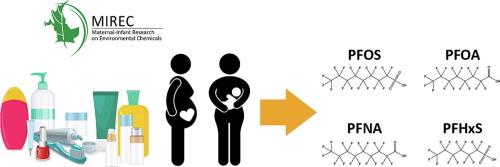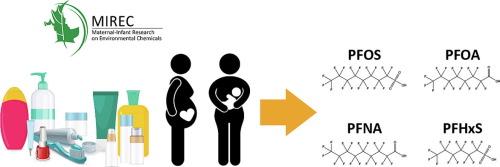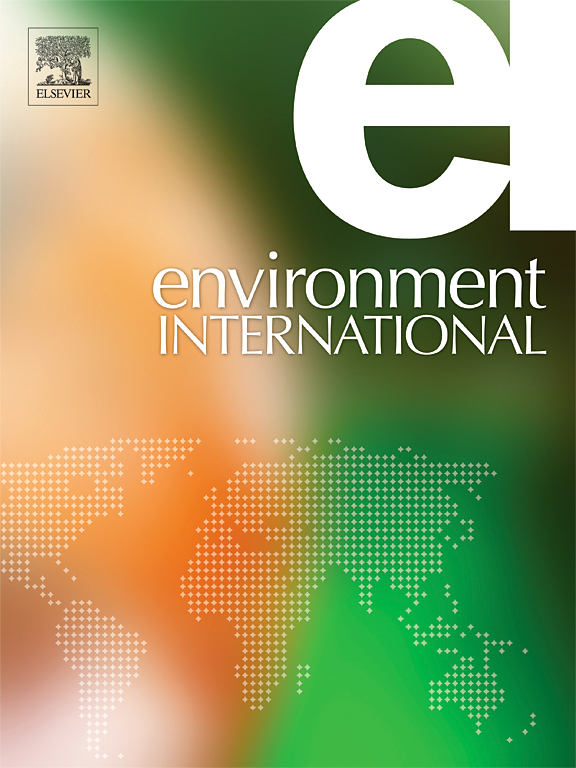母婴环境化学品研究中孕妇和哺乳期妇女使用个人护理产品与全氟和多氟烷基物质的情况
IF 9.7
1区 环境科学与生态学
Q1 ENVIRONMENTAL SCIENCES
引用次数: 0
摘要
背景全氟和多氟烷基物质(PFAS)是个人护理产品(PCP)中经常检测到的无处不在的化学物质。方法我们利用母婴环境化学品研究(MIREC)来评估使用五氯苯酚对产前血浆(妊娠 6-13 周;n = 1,940 例)和母乳(产后 2-10 周;n = 664 例)中 PFAS 浓度的影响。参与者报告了在妊娠期前三个月、妊娠期后三个月、产后 1-2 天和产后 2-10 周使用 8 种五氯苯酚的频率。我们使用线性回归模型来量化协变量调整后的百分比差异和相应的 95 % 置信区间。结果在怀孕前三个月,我们发现孕妇使用指甲护理产品的频率较高(每周≥一次 vs 从未使用:全氟辛酸 (PFOA):21 % [9.7 %, 32 %];全氟辛烷磺酸 (PFOS):11 % [0.3%,23%])、香料(每天使用与从不使用:PFOA:14%[7.8%,21%];PFOS:7.8%[1.3%,15%])、化妆品(每天使用与从不使用:PFOA:14%[5.8%,23%])、染发剂(从不使用与> 怀孕期间使用两次:PFOA:8.3%[2.4%,15%])以及喷发剂或凝胶(每天使用与从不使用:PFOA:12%[5.8%,23%]):PFOA: 12 % [5.0 %, 19 %],PFOS: 7.1 % [0.2 %, 15 %],PFHxS: 9.9 % [0.6 %, 20 %])与较高的血浆 PFAS 浓度有关。怀孕三个月使用五氯苯酚和产后 2-10 周母乳中的全氟辛烷磺酸浓度也有类似结果。此外,我们还发现,产后 1 至 2 天内使用彩色永久性染料的人群,其产后母乳中 Sm-PFOS(18%[2.7%, 35%])、PFOA(16%[4.3%, 29%])和全氟壬酸(17%[3.6%, 33%])的浓度较高。这些结果以及越来越多的科学证据有助于为全氟辛烷磺酸的监管提供信息,并指导个人选择减少接触全氟辛烷磺酸。本文章由计算机程序翻译,如有差异,请以英文原文为准。


Personal care product use and per- and polyfluoroalkyl substances in pregnant and lactating people in the Maternal-Infant Research on Environmental Chemicals study
Background
Per- and polyfluoroalkyl substances (PFAS) are ubiquitous chemicals routinely detected in personal care products (PCPs). However, few studies have evaluated the impact of PCP use on PFAS concentrations in pregnant and lactating populations.
Objective
We investigated associations between PCP use and PFAS concentrations in prenatal plasma and human milk.
Methods
We leveraged the Maternal-Infant Research on Environmental Chemicals (MIREC) Study to evaluate the contribution of PCP use on PFAS concentrations in prenatal plasma (6 to 13 weeks’ gestation; n = 1,940) and human-milk (2 to 10 weeks’ postpartum; n = 664). Participants reported frequency of use across 8 PCP categories during the 1st and 3rd trimesters, 1 to 2 days postpartum, and 2 to 10 weeks’ postpartum. We used adjusted linear regression models to quantify percent differences and corresponding 95 % confidence intervals.
Results
In 1st trimester pregnant people, we found higher use of nailcare products (≥once a week vs. never: perfluorooctanoic acid (PFOA): 21 % [9.7 %, 32 %]; perfluorooctane-sulfonic acid (PFOS): 11 % [0.3 %, 23 %]), fragrances (daily vs. never: PFOA: 14 % [7.8 %, 21 %]; PFOS: 7.8 % [1.3 %, 15 %]), makeup (daily vs. never: PFOA: 14 % [5.8 %, 23 %]), hair dyes (never vs. 1-2 times during pregnancy: PFOA: 8.3 % [2.4 %, 15 %]), and hair sprays or gels (daily vs. never: PFOA: 12 % [5.0 %, 19 %], PFOS: 7.1 % [0.2 %, 15 %]) were associated with higher plasma PFAS concentrations. Similar results were observed for 3rd trimester PCP use and 2 to 10 weeks’ postpartum human-milk PFAS concentrations. In addition, we also found that people using colored-permanent dye 1 to 2 days postpartum had higher Sm-PFOS (18 % [2.7 %, 35 %]), PFOA (16 % [4.3 %, 29 %]), and perfluorononanoic acid (17 % [3.6 %, 33 %]) postpartum human-milk concentrations.
Conclusions
Our results show that PCP use may be a modifiable source of PFAS exposure in pregnant and lactating populations. These results along with growing scientific evidence can help inform PFAS regulation and guide individual choices to reduce PFAS exposure.
求助全文
通过发布文献求助,成功后即可免费获取论文全文。
去求助
来源期刊

Environment International
环境科学-环境科学
CiteScore
21.90
自引率
3.40%
发文量
734
审稿时长
2.8 months
期刊介绍:
Environmental Health publishes manuscripts focusing on critical aspects of environmental and occupational medicine, including studies in toxicology and epidemiology, to illuminate the human health implications of exposure to environmental hazards. The journal adopts an open-access model and practices open peer review.
It caters to scientists and practitioners across all environmental science domains, directly or indirectly impacting human health and well-being. With a commitment to enhancing the prevention of environmentally-related health risks, Environmental Health serves as a public health journal for the community and scientists engaged in matters of public health significance concerning the environment.
 求助内容:
求助内容: 应助结果提醒方式:
应助结果提醒方式:


